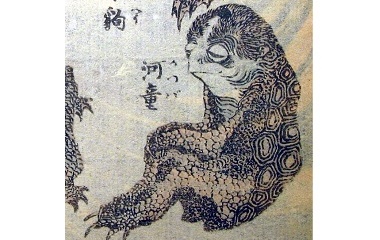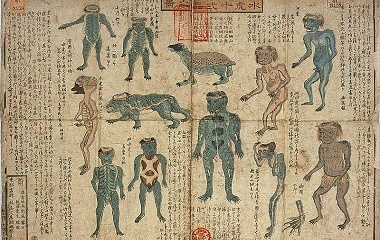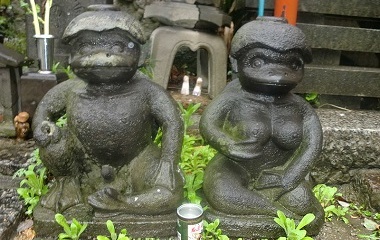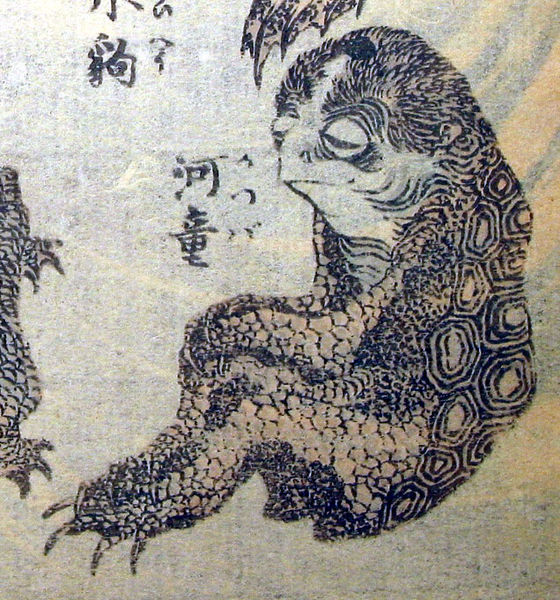In the waters of Japan there lurks a creature that is as mysterious as it is terrifying – the Kappa. This strange creature is thought to hold magical powers that can be used for both good and evil. Unfortunately, the Kappa prefers to use its gifts to play tricks on humans or lash out violently towards them. Though many refuse to believe in the existence of the Kappa, there are still many sightings today – especially in the countryside of Japan. In fact, locals still hang warning signs near bodies of water thought to be frequented by the Kappa.
What is a Kappa
The Kappa is a mythological monster said to inhabit ponds and rivers in Japan. This strange creature is said to have the appearance of both a humanoid and reptile and are extremely cunning. Kappas have over 80 different names, though the most common are kawappa, gawappa, and kawaso.
Kappa considered to be a type of suijin (water deity) that inhabits the freshwater areas of Japan. According to legend, the Kappa is fond of causing mischief and even harm towards humans. A Kappa’s pranks can manifest in the form of harmless jokes like making noises similar to flatulence or looking up a woman’s kimono. However, some Kappa are more violent and have been known to try to drown livestock, kidnap and eat children, and force themselves upon women.
Although Kappa are generally considered a force to be feared, there are some instances in which the Kappa are considered to be generous – though this most often happens when a Kappa is indebted to a human being. Some of the most common records of friendly Kappa are early Japanese legends that attribute the knowledge of bone setting and medical salves as being taught to man by friendly Kappa.
Characteristics
Physical Descriptions
Descriptions of Kappa vary from region to region, but most of the details are similar. Kappa are said to be about the size of a small child (never more than 5 feet tall) and have relatively small frames. In fact, the word ‘Kappa’ actually translates roughly to ‘water child.’ Their hands and feet are webbed and they are said to have amazing swimming capabilities.
Kappa also have scaly skin, similar to that of a reptile. Their skin color varies, but is said to come in hues of yellow, green, and blue. Kappas are said to have a humanoid figure with the shell of a tortoise on its back. Additionally, most Kappa have long, shaggy hair that is usually shaped in a bowl cut. They also have a beak for a mouth, though this doesn’t seem to interfere with their abilities to speak in human languages.
Last but not least, all Kappa have a small bowl-like dent on top of their heads that holds a small pool of water called the ‘sara.’ This water is though to be the source of the Kappa’s magical powers. A Kappa must keep their sara full whenever they venture onto land or forfeit all their strength and magical powers. Without this water, a Kappa could possibly die. However, it is thought that if you refill the sara atop a Kappa’s head, they will be eternally grateful and will help you with whatever you require for the rest of your lifetime.
There are also reports of a type of hairy Kappa that are known as hyosube, which are thought to be hungry ogre-like monsters.

Personality
Kappas are considered to be malevolent creatures that have a tendency to direct their anger towards humans and livestock. Some Kappa are pranksters that like to make offensive jokes that people uncomfortable like making sounds similar to flatulence or looking up a woman’s kimono. Other Kappa are more violent and purposefully try to drown livestock and small children, drink the blood of victims, and sexually assault women.
According to lore, Kappa are obsessed with an object called shirikodama – a mysterious jewel thought to contain a person’s lifeforce that is located in the shiri (anus). It is thought that the majority of attacks by Kappa are made to obtain the shirikodama. However, Kappa do not always kill for the purpose of touching or obtaining a shirikodama. Many myths tell of Kappa lurking in toilets (which were usually situated over the river) and waiting for an opportunity to sexually assault women. It was not uncommon for these women to later give birth to Kappa children. Upon birth, these children were cut into pieces and buried in jars because of their hideous appearance.
However, despite their evil ways, Kappa are obsessed with politeness and human tradition. This is considered to be its biggest weakness. Many who tell of a Kappa encounter in which they escaped claim that they were able to do so because they made the Kappa spill the water in its sara when they bowed. Kappa are also considered to be extremely trustworthy and honest. If you refill the water in the sara of a Kappa, it will help you with whatever you require or make a promise for whatever you ask.
Kappa are also considered to be extremely knowledgeable creatures. They are known to speak human languages even though they have a beak for a mouth and hold great knowledge of medical practices. It is said that the ancient tribes that inhabited Japan were able to lean the art of bone setting and the creation of medical salves from friendly Kappa.
Powers
The powers of a Kappa are thought to be magical and are greatly respected by all those who believe in the deity. All Kappas are known to posses incredible strength and impressive swimming capabilities. They are also known for their love of fighting – especially sumo wrestling. It is said that a Kappa’s greatest joy in life is to engage in combat with its victims. However, many are able to escape its invitation to fight by making a deep bow to the Kappa. According to legend, Kappas are obsessed with politeness and will return the bow, spilling their water in the process.
Kappas are also known to be extremely intelligent. They are credited with bringing many medical practices to the ancients of Japan including the art of bone setting and creation of many medicinal salves. It is said that if you befriend a Kappa, it will grant you with the knowledge of many medicinal practices.
How to defeat a Kappa
There are thought to be several ways to defeat or fend off a Kappa. The most common method was to use its own obsession with politeness and human tradition against it. It is said that if you encounter a Kappa, you should bow deeply to it. The Kappa will feel obligated to return the bow and will spill the water in its sara in the process, rendering it powerless. Be careful however – some Kappa have caught onto this practice and use a metal plate to protect their sara when they come ashore.
When it comes to Kappa who use a plate to protect their sara, there are other ways to ensure that they do not harm you. It is said that a Kappa’s arms can be easily detached from their bodies. If you can sneak up on a Kappa or are fast enough to grab their arm during combat and pull it off, a Kappa will promise you anything in order to have it returned. Many Japanese legends speak of heroes who overcame Kappa with this strategy and were able to obtain safety for their entire village in exchange for the returned arm.
Other ways of dealing with Kappa can be found in their love of certain foods – especially cucumbers. It is thought that cucumbers are one of the few things Kappa love more than the internal organs of young children. Many people believed that writing the names and ages of everyone in their family on pieces of sliced cucumber and throwing them into the water before bathing would ensure that no one in their family would be harmed. There is also a debate on whether eating cucumber would ensure safe passage in water. Those in certain regions believe that this will serve as protection, while others consider it to make a Kappa attack inevitable.
There are also several accounts of people being able to ward off Kappa by carrying iron, sesame, or ginger on their person.
Related Characters
There are several creatures that appear in lore from other ancient cultures and are thought to be related to the Kappa. One such creature is the Nix – a shapeshifting man that can be found in Norse mythology. Nix were known as beautiful creatures that had the power to draw women and children to the water’s edge with their sweet melodies. Malevolent Nix were known to drown their victims, though there were kind Nix who meant people no harm. In fact, some of these friendly Nix were thought to have married human partners.
There are also accounts of Siyokoy in the Philippines that are very reminiscent of the Kappa. The Siyokoy are creatures that are humanoid in appearance with scaly green skin. They are also thought to have webbed hands and feet, similar to that of a Kappa. They are known to drown humans and eat them. They are commonly accompanied by creatures like eels, rays, and squid.
Explanation of the Myth
Urban Myth to Scare Children
There are many who would explain the legend of the Kappa as a simple story for children to scare them into behaving. One of the most common types of Kappa stories are focused on the creature’s fixation on disobedient children. It was thought that when disobedient children ventured too close to the water without their parents, the Kappa would pull them into the water and drown them. There are several variations as to what would happen next. Some stories simply state that the Kappa kidnapped the children, while others detailed that the Kappa would drink the blood of their victims or eat their internal organs.
It is thought that this tale of the Kappa helped to reduce the number of children who were lost to drownings or other misfortunes by ensuring that the children stayed with their parents and didn’t wander off into danger.
Otherworldly Creatures
There are also those who believe that the Kappa could be a type of alien creature that somehow found its way to Earth. Many who have faith in this argument also believe that other mythological sea creatures inhabit Earth in the uncharted areas of the sea.
Their argument? These strange sea aliens are able to travel to and from the Earth through portals – which may explain why we’ve never been able to prove their existence. They claim that these portals come in the form of mysterious whirlpools. Admittedly, whirlpools and strong water currents are one of the most common descriptions that arise in mythology speaking of the appearance of these strange creatures.
Additionally, many scholars point out that several ancient cultures speak of sea creatures who are documented to have ‘fallen from the sky.’ Many of these creatures, gods, and goddesses are also said to have immediately submerged themselves in a body of water as soon as they arrived and are also credited with teaching human beings religion, culture, and medicine.
Likewise, the early Kappa are known as friendly helpers who worked to teach humans important medical practices such as bone setting.
Leech Babies
There also some who theorize that Kappa stories originated as a way to keep children away from bodies of water to keep them from seeing ‘leech babies.’ Leech babies were either stillborn infants or newborns that were killed by poor families that couldn’t afford to care for them. These children were then thrown into rivers, lakes, and ponds – the same places said to be inhabited by the Kappa.
In the ancient world, it was very common to encounter a leech baby because of the high number of struggling families that simply couldn’t afford to take care of them. Whether the story of the Kappa was meant as a warning for what could become of disobedient children, or an explanation for the horrible sight that could have been terrifying to the young of ancient Japan, many are certain that leech babies are the root of the Kappa legends.
The Japanese Giant Salamander
Still others claim that the legend of the Kappa is no more than a fear of the Japanese giant salamander. These salamanders grow to be up to 5 feet in length and have skin tones similar to that of the Kappa. The Japanese giant salamander are also known for grabbing their prey with their strong jaws and pulling them into the water. Coincidentally, Japanese giant salamanders are also known to frequent the same areas as the Kappa – rivers, lakes, and ponds.










